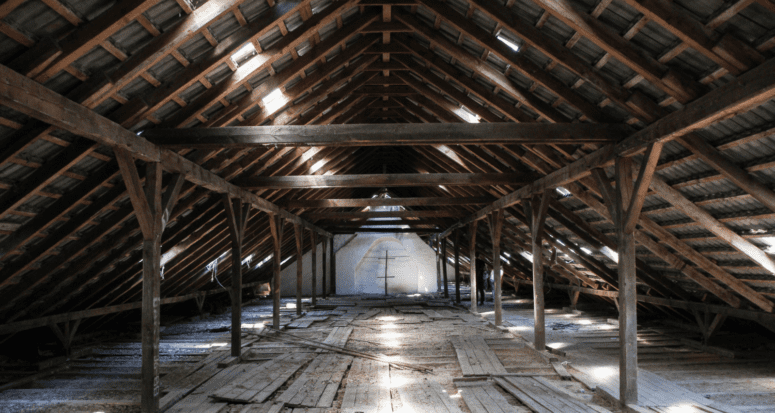My Attic Has No Insulation — Should I Invest in Adding Some?
- Published on
- 5-6 min read
-
 Christine Bartsch Contributing AuthorClose
Christine Bartsch Contributing AuthorClose Christine Bartsch Contributing Author
Christine Bartsch Contributing AuthorFormer art and design instructor Christine Bartsch holds an MFA in creative writing from Spalding University. Launching her writing career in 2007, Christine has crafted interior design content for companies including USA Today and Houzz.
Perhaps you’ve noticed that your upstairs master bedroom is always 8 to 10 degrees colder than the rest of your home in the winter and hotter by the same margin in the summer. So you venture into your attic and suddenly realize that something is missing… insulation!
If your attic has no insulation, you’re risking more than poor temperature regulation. We spoke with an experienced real estate agent and a few home repair experts from Neighborly to learn exactly why attic insulation is essential to your home’s health and what to do if your attic lacks insulation.

Yes, it’s a problem that your attic isn’t insulated
While attic insulation may not seem essential, there are several downsides to leaving this space exposed to the surrounding environment.
You’ll have higher energy bills
Heat rises, and when the weather grows cold, your expensive, HVAC heat escapes through your uninsulated attic. If you invest in attic insulation, you can trap the heat in your home and significantly reduce your energy bills.
“In south Georgia, I had a 2,600 square foot one-story ranch home that had electric bills up to $600 a month with the old roll-out insulation in the attic. We paid $2,700 to get the spray foam insulation, and our electric bill went down to $200 a month,” recalls Savannah, Georgia-based agent Teresa Cowart, who works with 77% more homes than the average agent.
Regions with hot climates also benefit from attic insulation. Insulation specially formulated with a radiant barrier protects your house from the sun beating heat down on your roof, which in turn reduces how often you run your air conditioning.
Ice dams can form on your roof
When your attic isn’t insulated, the heat that escapes through the roof can lead to ice dams during colder seasons. These dams impact the structural integrity of your roof over time.
“An ice dam is a ridge of ice that forms along the edge of a roof or on top of a home’s gutters. As snow and ice melt and mix with new moisture, the ice compresses and builds in layers, becoming a dangerous dam blocking water from running off the roof,” explains Joshua Miller of Rainbow International Restoration, a Neighborly company.
“Eventually, this water and moisture enters the home and can potentially cause damage to the ceiling or walls. Ice dams can also cause structural degradation, electrical problems, and can be a breeding ground for dangerous mold to grow.”
Attic insulation impacts your home at resale
When it’s time to sell, the absence of attic insulation probably won’t make or break your home sale. However, it can negatively impact the sale in several ways.
Home inspectors flag inadequate attic insulation
For starters, the lack of insulation will come up in the home inspection process.
“When selling your home without proper insulation, the insulation line item will be rated as “Poor/Deficient” with a recommendation of adding insulation to improve energy savings,” explains Joe Tangradi of HouseMaster, a Neighborly company.
Tangradi advises that home inspectors note the amount of insulation present, measured in inches. For most regions, 10 inches of insulation (an R-value of 30) is considered adequate.

If the inspection deems your attic un- or underinsulated, your buyers may ask you to add more insulation or pay them to do so before moving forward with the sale.
Attic insulation can add value to your home
In areas where extreme weather is an issue, the right kind of insulation can impact your home’s value. Remodeling Magazine reports that the average attic air-seal and fiberglass insulation job costs $1,343 and adds $1,446 in value at resale.
“In Georgia, spray foam insulation is seen as an added value versus the blown-in insulation,” advises Cowart.

Types of attic insulation
There are several types of insulation to choose from that vary in material, ease of installation, effectiveness, and cost.
Rolled insulation
Rolled insulation is by far the cheapest option as it typically costs only $0.12 to $0.90 per square foot, depending on its R-value and specialty features like radiant barriers. This type of insulation is also relatively simple to install if you have an attic without many hard-to-reach nooks and crannies.
“Roll out insulation installation isn’t rocket science, but it’s a hot, sweaty, itchy, and meticulous job. And attics often don’t have solid flooring throughout, so you risk putting your foot through the ceiling, which will cost you more money to repair,” says Cowart.
Loose-fill insulation
Loose-fill insulation is a bit pricier, ringing in at around $1 to $1.50 per square foot. It can be tricky to calculate the total cost of loose-fill insulation for your attic. You need to factor in the price differences between the different R-value levels, as well as how deep the loose-fill insulation needs to be in your area.

Spray foam
Spray foam is the most effective insulation since it spreads over surfaces evenly, then hardens and tightens to create a perfect fit barrier. Spray foam is also easier to get into the hard-to-reach nooks and crannies, so you’re not leaving any gaps where hot or cold outside air can get into the house.
There are two types of spray foam insulation: open cell and closed cell. Ask your local insulation expert which type is better for your region.

Attic insulation installation: DIY vs. hire-out
Attic insulation costs vary depending on if you hire a pro to install it or go the DIY route.
DIY your attic insulation
If you want to save money, you can install insulation yourself. Installing loose-fill insulation is fairly easy even for those who are new to DIY.
Along with the insulation, you’ll need to rent the blower, which ranges from around $90 for four hours to $125 for a full day. You may also be able to snag a free blower rental from the place where you purchase your insulation.
The drawback of DIYing your insulation is that self-installed insulation can prove ineffective if you don’t know what you’re doing. If you don’t have the tools or skills to properly get insulation into those hard-to-reach spaces, or you aren’t careful about achieving full coverage in your attic, your insulation cannot fully insulate your house.
Hire a professional
Alternatively, you can hire a professional to install insulation for $40 to $70 an hour on top of the cost for the insulation itself. If you go this route, Cowart advises opting for spray foam insulation over loose-fill:
“Spray foam is the longest lasting and best option in terms of added value, however in my experience, spray foam insulation is only done by professional companies. You won’t see a return immediately on spray foam insulation, but if you intend to live in your home for any amount of time, it’s worth it.”
Insulate that attic ASAP!
If you want to protect your roof and lower your energy bills, insulate your attic as soon as possible. Uninsulated attics experience condensation issues throughout the year in all but the driest of climates (though in these climates, an uninsulated attic can hurt your HVAC over time). Regions with cold winters and hot, humid summers are the most prone to ice dams and mold issues.
“The greatest importance of attic insulation is the ability to control moisture. This is because moisture creates a place where mold and mildew can thrive, and therefore creating greater issues for the homeowner and those residing in the home,” advises Miller. “With proper attic insulation, the humidity in the attic should remain at a balanced level, preventing these hazardous issues from happening.”
Header Image Source: (Sebastian Herrmann / Unsplash)
